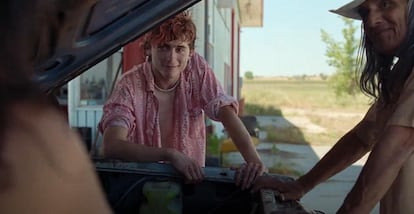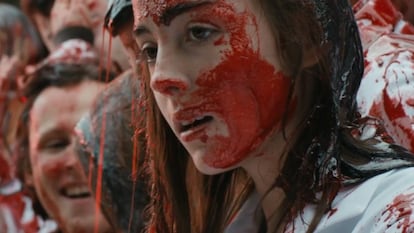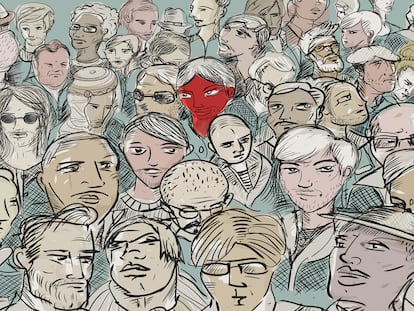Ambition, sex, cannibalism: Why stories about ravenous women have multiplied
With series and movies such as ‘Yellowjackets’ and ‘Bones and All,’ female characters with an unbridled appetite have become a hallmark of our culture

“To eat or not to eat?” Shauna might be saying as she stares at a freshly severed ear at the beginning of the second season of Yellowjackets. It is the ear of her best friend, now dead after succumbing to the first winter frost. In the end, Shauna, played by Sophie Nélisse, eats it, opening the floodgates to a cannibalistic orgy in which her friend Jackie (Ella Purnell) is devoured by a group of hungry young women who give in to their uncontrollable appetite. Fans of the successful series, which is breaking audience records in the U.S., took to social media to celebrate that its protagonists, a group of girls subsisting in the forest after a plane crash, go for it, breaking one of humanity’s most profound taboos. Affectionately referring to them as “our cannibals,” the audience seemed to be waiting for that first bite with the shadow of the 1846 Donner party — the one that inspired the series’ creators, Ashley Lyle and Bart Nickerson involving a survival and cannibalism.
This celebration of cannibalism presented as both repellent and attractive is not a one-off. Female hunger is prompting numerous narratives on our screens as a vehicle for character development such as the transformation that women undergo as they reach adulthood. This is the case of Bones and All, the latest film by Luca Guadagnino, the director of Call Me By Your Name (2017), which tells the story of emancipation, love and the satiation of two young cannibals with outsized appetites. Then there’s Raw by director Julia Ducornau, 2016, a forerunner of this trend that combines naturalistic and plausible aesthetics with a monstrous cannibalistic narrative, which had hitherto been confined to the realms of horror. In both films, the protagonists have to accept the uncontrollable urges that shape their identities — a twist on the traditional coming-of-age narrative.

“They are a kind of bildungsroman [coming-of-age novel],” explains David Conte Imbert, a researcher in literary theory and professor at Madrid’s Carlos III University. “In Raw, the girl learns to define herself and accept who she is as she enters adulthood crossing the line between the civilized and the savage. Obviously, there is the affirmation of an appetite, a hunger, which has to do with desire and is therefore erotic.” This also applies to Bones And All, which ends with one of the lovers, Maren, played by Taylor Russell, eating the other, Lee, played Timothée Chalamet, and to Yellowjackets, where the act of eating Jackie is the sublimation of a friendship that has been tense and ambivalent.
Given the numerous associations between passion and cannibalism, as in Up, Down, Fragile (Jacques Rivette, 1995) in which two friends eat a chicken while fantasizing and joking that it is the body of the man one of them loves; or the poem by Anne Sexton when she wrote: “Eat me up like a cream pudding / Take me in / Take me” is eating the ultimate erotic fantasy? “If there is cannibalism and romance, devouring is the transfiguration of love,” says Conte.
Although the narratives of monstrous women have traditionally been linked to the male gaze — with classic films such as Cat People (Jacques Tourneur, 1942) appealing to the myth of castration or the figure of the praying mantis to man’s fear of being devoured by a woman — this alternative type of liberating hunger is vindicated by certain branches of feminism, being linked to the Dionysian, which seems to be re-emerging simultaneously in several places in our culture. It is no coincidence that the girls in Yellowjackets imagine themselves dressed as Greek women while they turn their friend’s corpse into a banquet; as Conte explains, there are several myths related to female figures, such as the erinias or the bacchantes, where this type of devouring features prominently.
To speak of appetite in fiction is to speak of surplus and dearth, of conflict and crisis. In her novel, The Life of Hunger, Amélie Nothomb takes us to an island in the South Pacific whose inhabitants do not care about food: they have everything they need at their disposal — fruit and seafood in abundance — and they live satiated, with no appetite. This intrigues the narrator, a woman who was born hungry: a super hunger that drives her autobiography and leads to an anorexia-bulimia crisis. “It’s not just about food, but about everything that life has to offer, and that suddenly explodes,” Conte says. As in Lara Williams’ Supper Club, hunger can indicate either desire or compensation.

An uncontrollable, monstrous hunger is one of the first symptoms experienced by the protagonist of Rachel Yoder’s Nightbitch. Overwhelmed by the changes wrought by motherhood and raging under excessive patriarchal pressure, she begins to turn into a dog. “I think female desire has always been coded as monstrous,” says Yoder. “If we are too hungry, too horny, too ambitious, it is perceived as a transgression.” She does not describe an elegant, feline transformation, nor an angelic one; she does not appeal to the stylized monstrosity of the femme fatale as is done in Cat People. Yoder vindicates the mess and focuses on the reality of the bodily transformations that women undergo at different moments of their lives.
According to Yoder, if our bodies are too big or hairy, not properly domesticated, we are perceived as bad women who have not submitted to the rules that patriarchy laid down for us. As Conte explains, a return to savagery has potential because it involves scrapping the rules: “The rupture of civilization’s established schemes allows a sort of creation ex nihilo, from nothing to building independently of the social categories that generate places and roles for women, delving instead into the wild and primal,” he says. Rachel Yoder’s novel addresses this: “In my book, I wanted to challenge the monstrous characterization of female desire,” she says. “Perhaps becoming monstrous, embracing our desire, rather than consuming ourselves, may be what will set us free.”
On the one hand, the trend is clear: audiences are responding to this call to de-hygienize discourses around the female body and liberate, in the malleable terrain of fiction, those impulses that until very recently were either disciplined, erased, or kept at bay. Series like Yellowjackets and its journey into the wild seem to respond to Yoder’s rallying cry: “It’s time to bring women back down to earth, to the muck and blood and shit of our humanity. I don’t want to be a perfected Mary, I want to be a dirty she-wolf, because she is closer to the truth,” Yoder says.
However, certain branches of feminism also warn of the danger of overemphasizing the animalistic aspect of women and their relationship to nature, which can quickly slip into essentialist views of gender. Similarly, the overthrowing of every rule can discourage, as in the case of Raw — the story of a failed vegetarian — the recognition of one’s own agency in ethical food issues, where questioning is urgent. “I always tend to be suspicious of essentialist views that link women to nature and the earth because they are in contact with telluric forces, giving birth and life, something that appears a lot in ecofeminism and feminist ecocriticism,” says Conte. “As Simone de Beauvoir says in The Second Sex — the book that argues you become a woman rather than being born one — that is also a type of slavery.” How do we vindicate ourselves then without determining ourselves, and without leaving out those who may feel alienated by this binary rhetoric of the return to the body through what has been considered in the past to be monstrous?
For Rachel Yoder, the answer is a pragmatic one: “We just have to keep reading and writing and paying attention, understanding that there are no conclusions, only questions, images and stories to explore,” she says. “Where one story may fall short, or trap us rather than allow us to grow, comes the need for a new story. It is a process that evolves and never ends, a path towards emancipation from the old myths that limit us.” Mouthful by mouthful, until a larger and larger body of experience is incorporated. Mouthful by mouthful, until we are satiated.
Sign up for our weekly newsletter to get more English-language news coverage from EL PAÍS USA Edition
Tu suscripción se está usando en otro dispositivo
¿Quieres añadir otro usuario a tu suscripción?
Si continúas leyendo en este dispositivo, no se podrá leer en el otro.
FlechaTu suscripción se está usando en otro dispositivo y solo puedes acceder a EL PAÍS desde un dispositivo a la vez.
Si quieres compartir tu cuenta, cambia tu suscripción a la modalidad Premium, así podrás añadir otro usuario. Cada uno accederá con su propia cuenta de email, lo que os permitirá personalizar vuestra experiencia en EL PAÍS.
¿Tienes una suscripción de empresa? Accede aquí para contratar más cuentas.
En el caso de no saber quién está usando tu cuenta, te recomendamos cambiar tu contraseña aquí.
Si decides continuar compartiendo tu cuenta, este mensaje se mostrará en tu dispositivo y en el de la otra persona que está usando tu cuenta de forma indefinida, afectando a tu experiencia de lectura. Puedes consultar aquí los términos y condiciones de la suscripción digital.
More information
Archived In
Últimas noticias
Luisa Neubauer, climate change activist: ‘Ecology shouldn’t be a punitive force, but a joyful and liberating one’
Trump followed CIA recommendation to hand power to Delcy Rodríguez due to risk that Machado would not control the army
The Motherwell painting that Franco wanted to hide from view
Mexico seeks to shore up its defenses following US incursion in Venezuela
Most viewed
- Alain Aspect, Nobel laureate in physics: ‘Einstein was so smart that he would have had to recognize quantum entanglement’
- Alvin Hellerstein, a 92-year-old judge appointed by Bill Clinton, to preside over Maduro’s trial in New York
- Cuba confirms death of 32 of its citizens in the US attack against Venezuela
- Gilles Lipovetsky: ‘If you want to live better and fall in love, take Prozac, don’t look to philosophy’
- Why oil has been at the center of Venezuela-US conflicts for decades









































